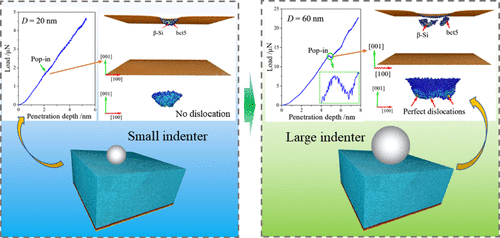当前位置:
X-MOL 学术
›
ACS Appl. Electron. Mater.
›
论文详情
Our official English website, www.x-mol.net, welcomes your
feedback! (Note: you will need to create a separate account there.)
Investigation of Indenter-Size-Dependent Nanoplasticity of Silicon by Molecular Dynamics Simulation
ACS Applied Electronic Materials ( IF 4.3 ) Pub Date : 2020-08-27 , DOI: 10.1021/acsaelm.0c00659 Jiapeng Sun 1 , Bingqian Xu 1 , Xiaoru Zhuo 1 , Jing Han 2 , Zhenquan Yang 1 , Jinghua Jiang 1 , Aibin Ma 1 , Guosong Wu 1 , Paul K. Chu 3
ACS Applied Electronic Materials ( IF 4.3 ) Pub Date : 2020-08-27 , DOI: 10.1021/acsaelm.0c00659 Jiapeng Sun 1 , Bingqian Xu 1 , Xiaoru Zhuo 1 , Jing Han 2 , Zhenquan Yang 1 , Jinghua Jiang 1 , Aibin Ma 1 , Guosong Wu 1 , Paul K. Chu 3
Affiliation

|
Silicon (Si) is commonly used in microelectronic devices and micro-/nanoelectromechanical systems, and the mechanical behavior of nanoscale silicon is very important. However, the origin of its nanoplasticity is still controversial, and it is not certain whether the elastic–plastic transition is determined by phase transformation or dislocation. Herein, molecular dynamics simulation is performed to reveal the nanoplasticity of Si at room temperature during nanoindentation with indenter diameters in the range of 20–100 nm. Our results predict an interesting indenter-size-dependent transition for the nanoplasticity of Si. When a small indenter is used, the high-pressure phase transformation (HPPT) is exclusively responsible for the elastic–plastic transition and subsequent incipient plasticity, giving rise to the strain-induced HPPT from the cubic diamond structure Si (dc-Si) to the β-Si and bct5 phases. However, for a large indenter, HPPT alone can no longer relieve the mechanical load, and dislocations are activated synchronously. In fact, the larger the indenter, the more prevailing are the dislocations. All the observed dislocations are the shuffle dislocation loops in the ⟨110⟩{111} slip system emitted from the high-pressure phases/dc-Si interface. Moreover, a large indenter promotes a sharp pop-in singularity in the load–penetration depth curve, but a small indenter gives rise to a gentle and difficult-to-detect pop-in singularity. Our findings shed light on the elastic–plastic transition controversy of Si and provide knowledge about the nanoplasticity of Si.
中文翻译:

分子动力学模拟研究压模尺寸依赖性硅的纳米可塑性
硅(Si)通常用于微电子设备和微/纳米机电系统中,纳米级硅的机械性能非常重要。然而,其纳米可塑性的起源仍然是有争议的,并且不确定弹塑性转变是由相变还是由位错决定的。在这里,进行分子动力学模拟以揭示在室温下压头直径在20-100 nm范围内的硅在室温下的纳米可塑性。我们的结果预测了Si纳米塑性的有趣的压头尺寸依赖性转变。当使用小型压头时,高压相变(HPPT)专门负责弹塑性转变和随后的初期可塑性,从立方金刚石结构Si(dc-Si)到β-Si和bct5相产生了应变诱导的HPPT。但是,对于较大的压头,仅HPPT不能再减轻机械负荷,并且错位会同步激活。实际上,压头越大,位错越普遍。所有观察到的位错都是are110⟩{111}滑移系统中高压相/ dc-Si界面发出的混洗位错环。此外,较大的压头会在载荷-穿透深度曲线中产生尖锐的弹入奇点,而较小的压头会产生柔和且难以检测的弹入奇点。我们的发现揭示了Si的弹塑性转变争议,并提供了有关Si纳米可塑性的知识。对于较大的压头,仅HPPT不能再减轻机械负荷,并且错位会同步激活。实际上,压头越大,位错越普遍。所有观察到的位错都是are110⟩{111}滑移系统中高压相/ dc-Si界面发出的混洗位错环。此外,较大的压头会在载荷-穿透深度曲线中产生尖锐的弹入奇点,而较小的压头会产生柔和且难以检测的弹入奇点。我们的发现揭示了Si的弹塑性转变争议,并提供了有关Si纳米可塑性的知识。对于较大的压头,仅HPPT不能再减轻机械负荷,并且错位会同步激活。实际上,压头越大,位错越普遍。所有观察到的位错都是are110⟩{111}滑移系统中高压相/ dc-Si界面发出的混洗位错环。此外,较大的压头会在载荷-穿透深度曲线中产生尖锐的弹入奇点,而较小的压头会产生柔和且难以检测的弹入奇点。我们的发现揭示了Si的弹塑性转变争议,并提供了有关Si纳米可塑性的知识。所有观察到的位错都是are110⟩{111}滑移系统中高压相/ dc-Si界面发出的混洗位错环。此外,较大的压头会在载荷-穿透深度曲线中产生尖锐的弹入奇点,而较小的压头会产生柔和且难以检测的弹入奇点。我们的发现揭示了Si的弹塑性转变争议,并提供了有关Si纳米可塑性的知识。所有观察到的位错都是are110⟩{111}滑移系统中高压相/ dc-Si界面发出的混洗位错环。此外,较大的压头会在载荷-穿透深度曲线中产生尖锐的弹入奇点,而较小的压头会产生柔和且难以检测的弹入奇点。我们的发现揭示了Si的弹塑性转变争议,并提供了有关Si的纳米塑性的知识。
更新日期:2020-09-22
中文翻译:

分子动力学模拟研究压模尺寸依赖性硅的纳米可塑性
硅(Si)通常用于微电子设备和微/纳米机电系统中,纳米级硅的机械性能非常重要。然而,其纳米可塑性的起源仍然是有争议的,并且不确定弹塑性转变是由相变还是由位错决定的。在这里,进行分子动力学模拟以揭示在室温下压头直径在20-100 nm范围内的硅在室温下的纳米可塑性。我们的结果预测了Si纳米塑性的有趣的压头尺寸依赖性转变。当使用小型压头时,高压相变(HPPT)专门负责弹塑性转变和随后的初期可塑性,从立方金刚石结构Si(dc-Si)到β-Si和bct5相产生了应变诱导的HPPT。但是,对于较大的压头,仅HPPT不能再减轻机械负荷,并且错位会同步激活。实际上,压头越大,位错越普遍。所有观察到的位错都是are110⟩{111}滑移系统中高压相/ dc-Si界面发出的混洗位错环。此外,较大的压头会在载荷-穿透深度曲线中产生尖锐的弹入奇点,而较小的压头会产生柔和且难以检测的弹入奇点。我们的发现揭示了Si的弹塑性转变争议,并提供了有关Si纳米可塑性的知识。对于较大的压头,仅HPPT不能再减轻机械负荷,并且错位会同步激活。实际上,压头越大,位错越普遍。所有观察到的位错都是are110⟩{111}滑移系统中高压相/ dc-Si界面发出的混洗位错环。此外,较大的压头会在载荷-穿透深度曲线中产生尖锐的弹入奇点,而较小的压头会产生柔和且难以检测的弹入奇点。我们的发现揭示了Si的弹塑性转变争议,并提供了有关Si纳米可塑性的知识。对于较大的压头,仅HPPT不能再减轻机械负荷,并且错位会同步激活。实际上,压头越大,位错越普遍。所有观察到的位错都是are110⟩{111}滑移系统中高压相/ dc-Si界面发出的混洗位错环。此外,较大的压头会在载荷-穿透深度曲线中产生尖锐的弹入奇点,而较小的压头会产生柔和且难以检测的弹入奇点。我们的发现揭示了Si的弹塑性转变争议,并提供了有关Si纳米可塑性的知识。所有观察到的位错都是are110⟩{111}滑移系统中高压相/ dc-Si界面发出的混洗位错环。此外,较大的压头会在载荷-穿透深度曲线中产生尖锐的弹入奇点,而较小的压头会产生柔和且难以检测的弹入奇点。我们的发现揭示了Si的弹塑性转变争议,并提供了有关Si纳米可塑性的知识。所有观察到的位错都是are110⟩{111}滑移系统中高压相/ dc-Si界面发出的混洗位错环。此外,较大的压头会在载荷-穿透深度曲线中产生尖锐的弹入奇点,而较小的压头会产生柔和且难以检测的弹入奇点。我们的发现揭示了Si的弹塑性转变争议,并提供了有关Si的纳米塑性的知识。









































 京公网安备 11010802027423号
京公网安备 11010802027423号